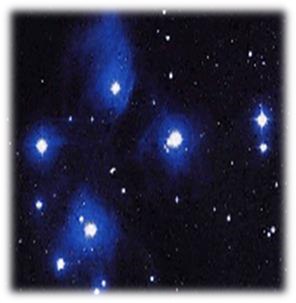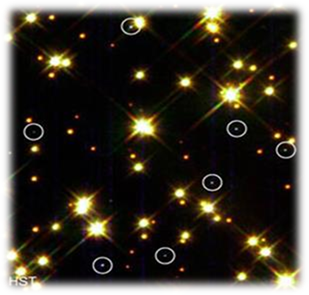STARS
![j0083191[1]](SCIPSU04_Stars_a_image003.png)
Unit Overview
Stars are one of the most
widely recognized objects in our night sky. While we can see roughly
3,000-4,000 stars at once in our limited view of the sky, the actual number of
stars existing in our universe is much, much higher. The exact number of stars
is not known, but it is estimated that there are over 100 billion galaxies in
the universe, and perhaps as many as 100 billion or more stars in each
galaxy.
The focus of this unit is
on the formation and life span of stars, as well as the tools used to classify
them. The sun in our solar system is a star, and since this is the closest
star, this will be used throughout the unit as a point of reference. The sun is
the center of our solar system and makes life possible on Earth.
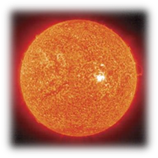
An image of the Sun,
captured by the Solar and Heliospheric Observatory
(SOHO) satellite, shows a bright, active region in the lower atmosphere, at
right of center. The image was taken in extreme ultraviolet light, with false
color added in processing.
 The
sun represents 99 percent of all the matter in our solar system. The
sun gives off light by fusing hydrogen into helium in its core. For
centuries, scientists were intrigued with how the sun gave off light. Since
early scientists were aware that burning coal gave off light, they originally
thought that the sun may be one large ball of burning coal. Their next very
logical question was, ďHow long could it burn?Ē The Earth was thought to be a
few thousand years old by early scientific observers, and they reasoned that a
ball of coal as large as the sun could probably burn that long. Later, it was
discovered that the Earth was actually billions of years old.
The
sun represents 99 percent of all the matter in our solar system. The
sun gives off light by fusing hydrogen into helium in its core. For
centuries, scientists were intrigued with how the sun gave off light. Since
early scientists were aware that burning coal gave off light, they originally
thought that the sun may be one large ball of burning coal. Their next very
logical question was, ďHow long could it burn?Ē The Earth was thought to be a
few thousand years old by early scientific observers, and they reasoned that a
ball of coal as large as the sun could probably burn that long. Later, it was
discovered that the Earth was actually billions of years old.
Scientists knew that coal
could not burn this long without being consumed. In the 1930ís, scientist began
experimenting with nuclear reactions and measuring the energy produced by those
reactions. The results of their experiments led the scientists to theorize that
a nuclear reaction which was very large would be capable of producing the
energy of the sun, as well as burning for billions of years.
Formation of Stars
The formation of stars begins in a type of nebula
known as a molecular cloud. As additional particles combine with the
cloud, its gravitational force increases. The temperature is very low, around
10 to 30 K, and the composition of the cloud is mainly hydrogen gas as well as
dust. Cloud turbulence causes the gas and dust to collapse under the force
of its own gravity. The core heats up in the process, giving rise to a protostar.
A protostar is a very young star that is still adding mass to itself from the
molecular cloud. (It is known that the center of the Earth is a hot matter, probably
molten liquid. This is caused by the tremendous pressure and resulting heat in
the center of the Earth as well as the gravitational pull.) Stars are much
larger than the Earth so the gravity is significantly greater and more pressure
is generated. This enormous pressure results in very high temperatures being
generated. When the center of a nebula reaches a temperature of 10 million
Kelvin (10,000,000K), fusion begins. Fusion is the joining
of the nuclei of atoms in a way that produces new elements. The fusion reaction
releases energy and a star is born.
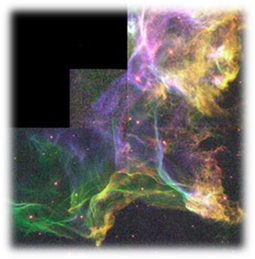
This
nebula is the product of a supernova
explosion; in this section, the blast wave has encountered an area of dense
interstellar gas, creating turbulence in the wave and causing it to glow. The
picture is a composite of three images taken by the Hubble Space Telescope.
Stars (and remember our sun is a star) subject
hydrogen to temperatures over a million degrees. Hydrogen molecules fuse
together and make helium.
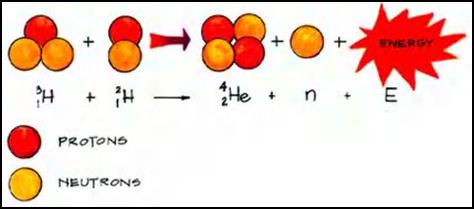
It takes two hydrogen molecules to make one
helium molecule. Since one helium molecule has less mass than four hydrogen
molecules, some hydrogen mass must be lost. The mass of hydrogen that is lost
in the fusion is converted into energy, and this is the light and heat that we
receive from the sun. Remember fuel is essential to produce energy and when you
run out of fuel, energy can no longer be produced. How long will the sun last
and continue to produce energy? Once it has consumed all the hydrogen, it can
no longer burn. Some stars consume all of their hydrogen in less than 1 million
years, while stars that are not as bright can have a life span of billions of
years. Our sun has a projected life span of around 10 billion years and it is
about half way through its life cycle.
Did you know that it takes eight minutes for light
from the sun to travel to the Earth? Light from the sun takes over four years
to travel to the nearest star.
|
|
|
|
|
The brightest stars in this field are
yellow stars similar to the Sun; smaller, dim stars are red dwarfs. |
Life
Cycle of Stars
Stars are constantly changing, just as we are. They are born, grow old,
and eventually die. The size of a star determines what its fate will be. In the
diagram below, you can see what happens to average size stars compared to
massive stars. An average star typically develops into a red giant as it
expands and cools. It will experience a planetary nebula phase and eventually
form a white dwarf star. White dwarfs are small and extremely dense. A massive
star, on the other hand, will continue expansion to a red supergiant. Toward the
end of the supergiant phase, the star will explode into a supernova. The
supernova can be as bright as a galaxy upon its explosion, but almost fades
entirely over the course of a week. What remains will be either a neutron star
or a black hole.
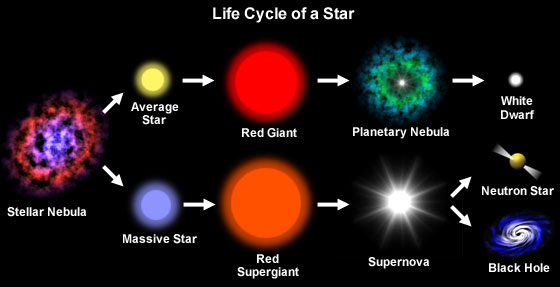
Video Clip: Life Cycles of Stars
For more information on a starís life cycle, watch the following video
clip and complete the guided notes. The video clip explores the life cycle of
stars and describes the events that occur as they are born, grow old, and die.
Life Cycle of Stars Guided
Notes
Video
Clip: Nuclear Fusion
The following video investigates the process of
nuclear fusion, the way that dust and gases in space combine to form stars.
The elements hydrogen and helium undergo nuclear fusion throughout the star's
life cycle. As you watch the video clip, complete the guided notes.
Optional
Extension: Further Reading on Star Formation
https://science.nasa.gov/astrophysics/focus-areas/how-do-stars-form-and-evolve
http://abyss.uoregon.edu/~js/ast122/lectures/lec13.html
Classification of Stars
Stars are classified according to their luminosity
(brightness), spectral type, temperature, color, and stage of evolution. A tool
astronomers use to classify stars is called the Hertzsprung-Russell
(H-R) diagram. In 1911, the Danish astronomer Ejnar
Hertzsprung used such a diagram to plot the absolute
magnitude of a star against its color. In a separate 1913 American study, Henry
Norris Russell used the same type of diagram to plot a starís absolute
magnitude against its spectral class. The data of these scientists showed that
there was a relationship between a starís temperature and luminosity. The mass
of the star determines its position on the main sequence.
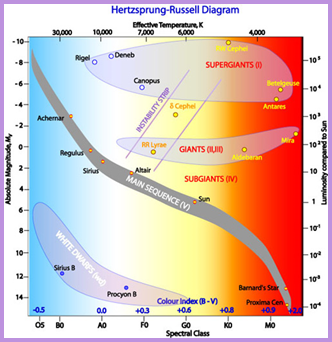
Most stars lie somewhere along the main
sequence on the H-R diagram. They include yellow dwarf and red dwarf
stars. The lower left corner of the diagram shows white dwarf stars, while the
upper right shows red supergiants. Red giants lie between the red supergiants
and the main sequence. The mass of a star determines its location on the main
sequence, as well as its pattern of evolution.
Quizlet Vocabulary:
